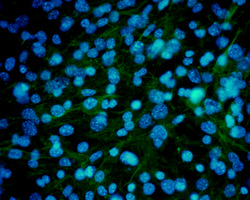
A genetic pathway previously known for its role in embryonic development and cancer has been identified as a target for systemic sclerosis, or scleroderma, therapy. The finding, discovered by a cross-disciplinary team led by John Varga, MD, John and Nancy Hughes Distinguished Professor of Rheumatology at Northwestern University Feinberg School of Medicine, was recently published in the journal Arthritis & Rheumatism.
“We showed, for the first time, that the Wnt signaling pathway is abnormally activated in scleroderma patients,” said Varga, who is also a physician at Northwestern Memorial Hospital. “This is significant for three reasons. First, it gives a better picture of scleroderma and fibrosis in general. Second, it provides a strategy for assessing disease severity, progression, and activity. And third, it opens a door for the design of treatments that aim to block the Wnt pathway and restore its normal controlled activity.”
Varga’s laboratory collaborated with a pulmonary team at Northwestern, along with teams at Case Western Reserve University and Dartmouth University on the discovery. The research was funded by the National Institutes of Health and the Scleroderma Research Foundation.
Researchers studied skin and lung biopsies from scleroderma patients and found that the Wnt pathway was ‘turned on’, in contrast to healthy individuals where the pathway was ‘turned off.’ Varga said this activation may be due to loss of Wnt inhibitors that normally serve as ‘brakes’ on the pathway to prevent its activation. The team also examined what the pathway does using fibroblasts and stem cells from healthy people. They found Wnt causes fibroblast activation and blocks the development of fat cells (adipocytes), which directly contribute to scar formation and tissue damage seen in scleroderma.
Scleroderma is a chronic autoimmune disease in which the body’s immune system attacks itself. It causes progressive thickening and tightening (fibrosis) of the skin and also can lead to serious internal organ damage and, in some cases, death. Scleroderma affects an estimated 150,000 people in the United States, most frequently young to middle-aged women.
“Scleroderma is a complex and poorly understood disease with no cure,” said Varga. “Our findings suggest that treatments targeting the Wnt signaling pathway could lead to an effective treatment.”
Varga said Northwestern researchers next plan to conduct multi-center preclinical studies to evaluate treatments that block the Wnt pathway in animal models and measure Wnt activity in additional scleroderma biopsies to see if it can be clinically useful as a biomarker.






